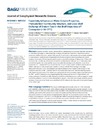Please use this identifier to cite or link to this item:
https://accedacris.ulpgc.es/jspui/handle/10553/31718
| Title: | Front-eddy influence on water column properties, phytoplankton community structure, and cross-shelf exchange of diatom taxa in the shelf-slope area off concepción (∼36–37°S) | Authors: | Morales, C. Anabalón, V. Bento, J. Hormazábal Fritz, Samuel Cornejo, M. Correa Ramírez, Marco Silva, N. |
UNESCO Clasification: | 2510 Oceanografía | Keywords: | Coastal upwelling Cross-shelf exchange Diatom taxa Eastern South Pacific Frontal zone, et al |
Issue Date: | 2017 | Journal: | Journal of geophysical research. Oceans | Abstract: | In eastern boundary current systems (EBCSs), submesoscale to mesocale variability contributes to cross-shore exchanges of water properties, nutrients, and plankton. Data from a short-term summer survey and satellite time series (January–February 2014) were used to characterize submesoscale variability in oceanographic conditions and phytoplankton distribution across the coastal upwelling and coastal transition zones north of Punta Lavapié, and to explore cross-shelf exchanges of diatom taxa. A thermohaline front (FRN-1) flanked by a mesoscale anticyclonic intrathermocline eddy (ITE-1), or mode-water eddy, persisted during the time series and the survey was undertaken during a wind relaxation event. At the survey time, ITE-1 contributed to an onshore intrusion of warm oceanic waters (southern section) and an offshore advection of cold coastal waters (northern section), with the latter forming a cold, high chlorophyll-a filament. In situ phytoplankton and diatom biomasses were highest at the surface in FRN-1 and at the subsurface in ITE-1, whereas values in the coastal zone were lower and dominated by smaller cells. Diatom species typical of the coastal zone and species dominant in oceanic waters were both found in the FRN-1 and ITE-1 interaction area, suggesting that this mixture was the result of both offshore and onshore advection. Overall, front-eddy interactions in EBCSs could enhance cross-shelf exchanges of coastal and oceanic plankton, as well as sustain phytoplankton growth in the slope area through localized upward injections of nutrients in the frontal zone, combined with ITE-induced advection and vertical nutrient inputs to the surface layer. | URI: | https://accedacris.ulpgc.es/handle/10553/31718 | ISSN: | 2169-9275 | DOI: | 10.1002/2017JC013111 | Source: | Journal of Geophysical Research - Oceans [ISSN 2169-9275], v. 122 (11), p. 8944-8965 | URL: | http://api.elsevier.com/content/abstract/scopus_id/85034604896 |
| Appears in Collections: | Artículos |
SCOPUSTM
Citations
12
checked on Jun 8, 2025
WEB OF SCIENCETM
Citations
10
checked on Jun 8, 2025
Page view(s)
114
checked on Jul 12, 2025
Download(s)
194
checked on Jul 12, 2025
Google ScholarTM
Check
Altmetric
Share
Export metadata
Items in accedaCRIS are protected by copyright, with all rights reserved, unless otherwise indicated.
